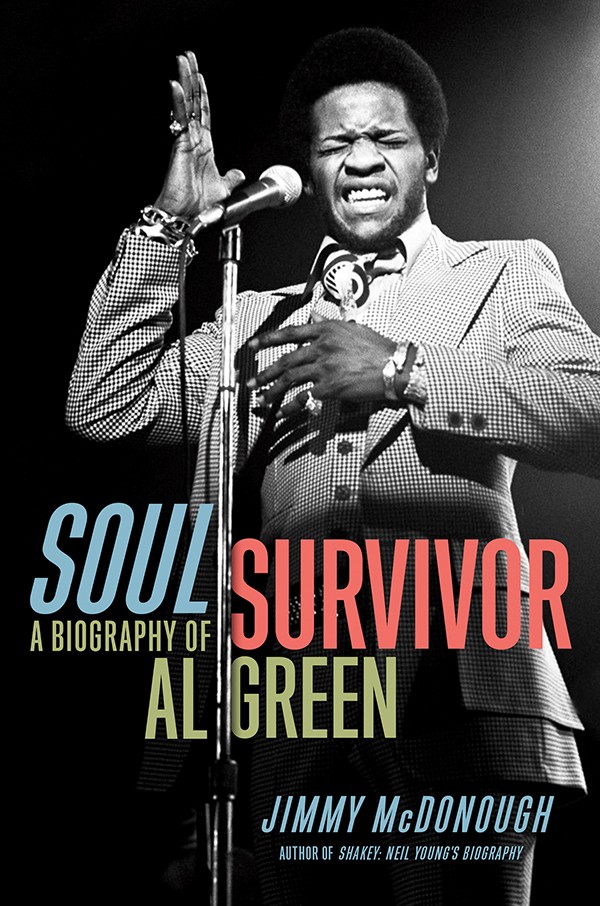No one could fault you for thinking author Jimmy McDonough was a musician. You can tell he’s a solid hang. That’s the great strength of his biographies, as was apparent in his first book, Shakey: Neil Young’s Biography. His first major work, its publication was hung up in court after Young backed out of the arrangement. Eventually it got out. The irony and genius of the book was that McDonough and Young spent a lot of time hanging out. He gives Young shit about his ’80s records; he praises and lambasts in equal measure; he asks the right questions. It’s gonzo.
Hitting the shelves this week, McDonough’s latest, Soul Survivor: A Biography of Al Green, doesn’t quite rise to the heights of Shakey for one simple reason: He doesn’t get a chance to hang with his principal subject. But the gonzo approach carries him through. He combs through every interview and every note of every album, for better or worse. And while blunt, McDonough is clearly a fan of the Reverend’s works, and smart enough to say why.
His love of Green’s masterpieces translates into a deep engagement with those who made those works possible — Willie Mitchell and the Hi Rhythm Section. McDonough wraps up the first chapter, which outlines Green’s early life and first days of touring, with this detour: “Al’s gonna disappear into the night for a few chapters while we set the stage for his arrival. To understand the greatness of Al Green, you have to experience the unlikely early days of Hi.” The next 60 pages go on to do just that, offering a pocket history of Hi Records and Royal Studios from 1956 on.
Here, McDonough recreates the magic of Royal, from the early hit instrumentals, through the growth of Mitchell as a producer and engineer, and into the early forays into a new sound with the young Al Green. McDonough’s ear for detail pays off here, as he teases out the elements that came to define Hi in the 1970s.

“Tired of Being Alone” was the breakthrough, and McDonough offers engineer Terry Manning’s insight into its creation: “The vocals are punched in so much that you really don’t ever hear a breath.” Later, he zeroes in on how Charles Hodges created his trademark organ swoops. He teases out the respective rhythmic contributions of Al Jackson Jr. and Howard Grimes. He recreates the session when Teenie Hodges insists on smoking a joint, then stomps the count-off to “Love and Happiness” on a Coca-Cola crate.
Most importantly, we get a portrait of Hi’s master architect, Willie Mitchell, as he curses, praises, and cajoles brilliant performances from all involved. “They worked on the vocal for eight days straight,” writes McDonough, who quotes Mitchell’s recollection that Green “just wouldn’t listen. Finally, he started to cry. I told him, ‘You sound like everybody out on the street. I want to hear Al Green.’ He said, ‘I don’t know who Al Green is.'”
This is a telling moment. It gets to the dark heart of the book’s mystery: Who is Al Green? On page one, McDonough quotes the ghost writer of Green’s “autobiography,” who says the singer “would walk in and out of the real world. … As far as I could tell, he had three different personalities.” McDonough tries to unravel the tangle with wide-ranging research. While he never gets a chance to interview Green in person, he certainly speaks to or finds interviews with nearly everyone else in Green’s life. At times the story can be fatiguing — a litany of musicians and companions who felt wronged or betrayed. But the overlapping narratives can also make for a gripping read, as with the jilted lover who attacked Green with boiling grits (or Cream of Wheat?) and then (maybe?) committed suicide. McDonough wisely balances these passages, which portray a loner prone to wild mood swings and questionable ethics, with in-depth readings of the works themselves, from the ridiculous to the sublime.
Even with the wheat and the chaff equally considered, the music gives Green’s life story a sense of hope. Near the end, an upbeat note is sounded when Green makes an album with the Roots. Drummer Questlove, who instigated the collaboration, makes an observation that sums up the whole book: “All musical geniuses are crazy. And Al is no exception to the rule. He’s channeling something that’s not normal … He’s from another planet.”